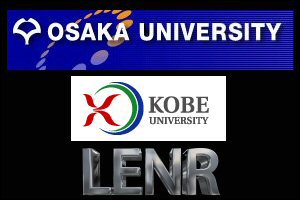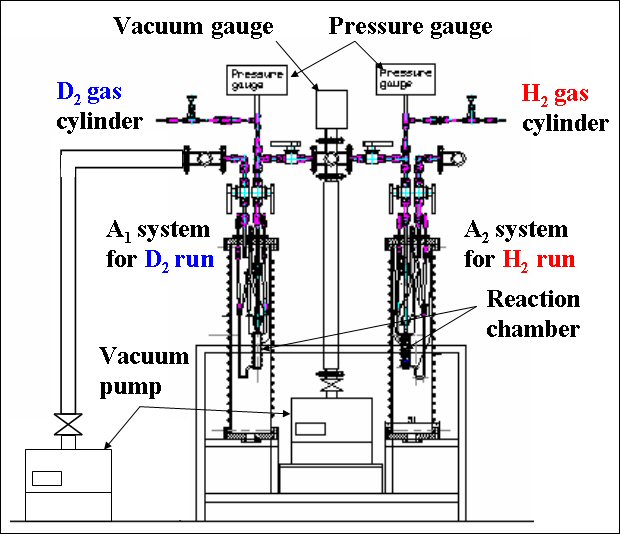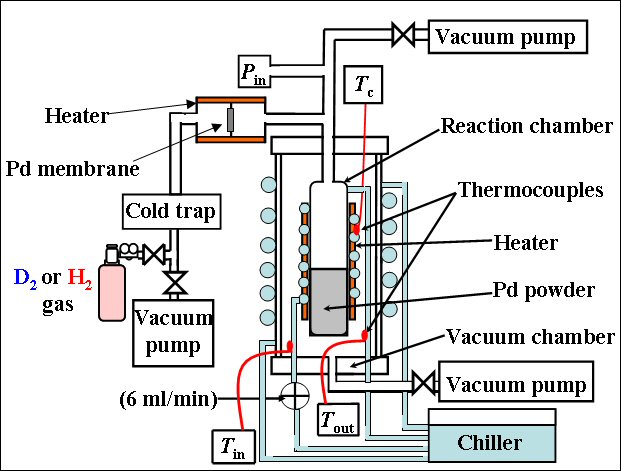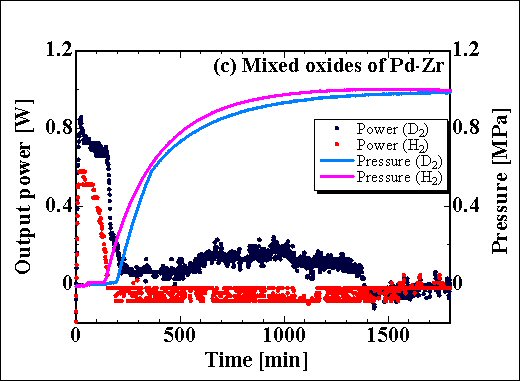Development Path of LENR Nanomaterial Research in Japan

Sept. 25, 2012 – By Steven B. Krivit –
[This is the second of a four-part series. Part 1 is here.]
This article reviews highlights of low-energy nuclear reaction research that uses the nanomaterial and hydrogen-isotope-gas absorption method. Most of the work originated in several Japanese universities. In the last few years, this research has also been sponsored by Technova, a Toyota subsidiary. Researchers at the Toyota Central Research and Development Laboratories in Nagakute, Aichi, Japan, have also begun experiments in this LENR method.
Aspects of this story trace back to at least 1926, when Fritz Paneth and Kurt Peters, of the University of Berlin, used finely divided palladium, also called palladium-black, in their room-temperature hydrogen-palladium experiments. Their claim and their subsequent self-doubt resulted in controversy, but their work represents an important marker in the history of low-energy nuclear reaction research.[1]
Akito Takahashi, professor emeritus at Osaka University, told New Energy Times that, many years later, Hiroshi Fujita, professor emeritus at Osaka University, came up with the idea of using nanoscale palladium-zirconium oxide materials. Fujita’s expertise was in atom clusters.
1992 – Tohoku University
In 1992, Hisamichi Kimura, Akihisa Inoue and Tsuyoshi Masumoto, researchers with the Institute for Materials Research at Tohoku University in Japan, reported hydrogen-absorption experiments based on specially prepared nanopowder materials they developed.[2] Takahashi told New Energy Times that the Tohoku University group was the first to use Fujita’s idea and make nanoscale palladium-zirconium oxide materials.
2002 – Osaka University
In 2002, Kimura, Inoue, Shin-ichi Yamaura and Ken-ichiro Sasamori, at the Institute for Materials Research, published a paper on hydrogen absorption of nanoscale palladium particles embedded in a zirconium oxide matrix. Co-authors on that paper were professors Yoshiaki Arata and Yue-Chang Zhang, at Osaka University. Arata was a friend and colleague of Fujita’s, according to Takahashi. Arata, Fujita and Inoue all worked in metal research.[3]
2005-2007 – Osaka University
Arata and Zhang broke new ground in 2005 with their use of nanomaterials in LENR experiments. Their work inspired Takahashi. He had retired from Osaka University in April 2004 and joined Technova as a senior adviser in October 2007. Soon after, he planned and directed a nanomaterial and hydrogen-isotope-gas absorption replication project.[4]
“We decided to set up a laboratory at Kobe University and contract with professor Akira Kitamura and his group,” Takahashi wrote.
2008 – Osaka University
In 2008, Arata and Zhang gave a public demonstration of their nanomaterial and hydrogen-isotope-gas absorption LENR experiment at Osaka University. The magnitude of the heat output was small; however, they used the heat to power a Stirling engine. After a kick-start from Zhang’s finger, the engine began and continued on its own to turn a small fan. This may have been the first visible demonstration of LENR energy.
Video of Arata-Zhang Osaka University 2008 Laboratory Demonstration
The experiment consists of a double-wall chamber (a Dewar), into which palladium nanopowder alloys are placed. In the first phase of the experiment, the researchers feed deuterium gas into the center of the chamber to load the gas into the nanopowder. During this time, a chemical reaction takes place while the deuterium absorbs into the palladium.
However, once the absorption process is complete, researchers see a second distinct phase. In the Arata-Zhang case, they saw a 50-hour, low-level heating phase during which there was no conventional explanation (aside from LENRs) for such self-heating.[5] There was no electrical input power, just gas pressure. For this reason, virtually all heat produced in the second phase is excess heat.
2008-2009 – Brian Ahern
In 2008, Brian Ahern, an independent U.S. researcher in Boxborough, Mass., began looking into the nanomaterial and hydrogen-isotope-gas absorption experiments. He was eager to see someone replicate the Arata/Zhang work. Ahern began communicating with and sending technical information to Takahashi in Nov. 2008. Ahern also began to seek materials for his own replication. (Ahern’s work is discussed in Article 4 of this series.)
2008-2009 – Technova/Kobe University
Takahashi and Kitamura, at the time a professor with the Division of Marine Engineering at the Graduate School of Maritime Sciences at Kobe University in Japan, and his students began a series of experiments that attempted to replicate the Arata/Zhang work. Kitamura is now retired from Kobe as professor emeritus.
Takahashi told New Energy Times that they had some challenges to get the right material.
“We asked Arata to use his group’s nano-Pd/ZrO2 sample, but he refused our request,” Takahashi wrote. “So we arranged to get our own samples from Santoku Co. in Kobe, Japan, in fall 2008.
“Santoku made and provided us with palladium-zirconium samples with a particle size of about 10 nanometers, dispersed in ZrO2 flakes. We used X-ray diffraction analysis on the samples to confirm the size.”
“We got the first convincing results, like those of Arata-Zhang, in January 2009,” Takahashi wrote. “We reported our results at the American Chemical Society meeting in Salt Lake City in March 2009.”
Takahashi told New Energy Times that the Technova/Kobe University results appeared to be the first successful replication of the Arata/Zhang experiment.
“As far as I know, ours was the first successful replication,” Takahashi wrote, “although Jean-Paul Biberian, Ivan Chernov and Talbot Chubb were making similar attempts in 2008-2009.”
Yu Sasaki, at the time a Kobe graduate student advised by Kitamura, also reported the successful Arata-Zhang replication at the 9th Meeting of the Japan CF-Research Society March 28-29, 2009, in Shizuoka, Japan.[6]
The Kobe configuration differed from the Osaka configuration in that, at Kobe, the researchers used two identical experimental chambers in parallel: one for the deuterium gas foreground experiment, the other for the hydrogen gas background experiment. The Osaka experiments used only one experimental chamber and performed foreground and background experiments in that same chamber, one at a time.

Fig. 1 from Kobe 2009 group paper: Twin System Experimental Configuration
At Kobe, the researchers also employed water-flow calorimetry (except in their later experiments, with higher-temperature runs), which can make it easier to obtain more reliable calorimetry. The researchers at Osaka used only isoperibolic calorimetry. Each chamber has an inner reaction compartment containing palladium powder and an outer compartment that is evacuated to provide thermal insulation for calorimetry.
A sheath heater is wound on the outer surface of the reaction compartment for baking the sample powder. A cooling water pipe, made of copper, also surrounds the outer compartment and is used for flow calorimetry to estimate the heat production rate.
A pair of thermocouples is provided for the flow calorimetry and measures the temperature difference between the inlet and the outlet of the cooling water. The researchers also have separate thermocouples for isoperibolic calorimetry. After the researchers bake the sample powder, the system is cooled to room temperature before the run starts. In the diagram below, the flow calorimetry is shown as “chiller.”

Fig. 2 from Kobe group 2009 paper: LENR Cell and Calorimetry System
Arata and Zhang had sought heat from the palladium-deuterium system only; therefore, at least initially, the Kobe researchers followed in the same line as the Osaka researchers.
In all cases with such experiments, the first thing researchers look for is the amount of deuterium that is absorbed into the nanopowders or nanomaterials. It is a well-established fact in the LENR field that, without high ratios of the hydrogen isotope loaded into a metal, no anomalous results will appear. High loading ratios are not easy to achieve, so this is a key parameter to look for. The Kobe researchers succeeded, and their results earned them a publication in the mainstream physics journal Physics Letters A.[7]
They reported experiments using palladium-zirconium-oxide powders that gave a high loading ratio of D / Pd = 1 . 1 ± 0 . 0 and H / Pd = 1 . 1 ± 0 . 3 in the first phase during deuteride/hydride formation. More important, they reported that their experiment produced an anomalously large rate of hydrogen isotope absorption, 2 . 4 ± 0 . 2 eV per deuterium atom and 1 . 8 ± 0 . 4 eV per hydrogen atom.
According to the authors, the known value for surface adsorption and that for lattice absorption of hydrogen atoms into bulk palladium metal are only 0.5 eV and 0.2 eV per hydrogen isotope atom, respectively. The researchers also observed that, in the second phase, the Pd-Zr mixed oxide sample charged with deuterium showed small but significant heat output.

Fig. 3c from Kobe group PLA paper: Small, Anomalous Heat Effect for Deuterium but Not Hydrogen with Pd-Zr Mixed Oxide Sample.
[Story continues in Part 3 of this series tomorrow.]
1. Paneth, F., and Peters, K., “Über die Verwandlung von Wasserstoff in Helium,” Berichte der Deutschen Chemischen Gesellschaft, 59, 2039-2048 (1926)
2. Kimura, Hisamichi, Inoue, Akihisa and Masumoto, Tsuyoshi, Mater. Lett. 14, 232, 1992
3. Yamaura, Shin-ichi, Sasamori, Ken-ichiro, Kimura, Hisamichi, Inoue, Akihisa, Zhang, Yue Chang and Arata, Yoshiaki, “Hydrogen Absorption of Nanoscale Pd Particles Embedded in ZrO2 Matrix Prepared From Zr–Pd Amorphous Alloys,” Journal of Materials Research Society, 17(6), June 2002
4. Arata, Yoshiaki, and Zhang, Yue Chang, “Development of ‘DS-Reactor’ as the Practical Reactor of ‘Cold Fusion’ Based on the ‘DS-Cell’ With ‘DS-Cathode’,” Proceedings of 12th International Conference on Condensed Matter Nuclear Science, Yokohama, Japan, p. 44-54, 2005
5. Arata, Yoshiaki, and Zhang, Yue Chang, “Research Project of New Energy Generation,” J. High Temperature Society, 34(1), Special Report at the end of issue, no pages are given, Jan 2008
6. Sasaki, Yu, Kitamura, Akira, Nohmi, Takayoshi, Miyoshi, Yuuki, Taniike, Akira, Takahashi, Akito, Seto, Reiko, Fujita, Yushi, “Deuterium Gas Charging Experiments With Pd Powders for Excess Heat Evolution,” JCF-9, 2009
7. Kitamura, Akira, Nohmi, Takayoshi, Sasaki, Yuuki, Taniike, Akira, Takahashi, Akito, Seto, Reiko, Fujita, Yushi, “Anomalous Effects in Charging of Pd Powders With High-Density Hydrogen Isotopes,” Physics Letters A, 373 (35), p. 3109-3112, 24 August 2009
Questions? Comments? Submit a Letter to the Editor.

